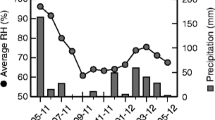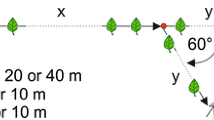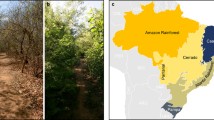Abstract
Stingless bees have evolved several ways to share contested resources to ensure the coexistence between different species. Partamona orizabaensis quickly exploits food sources by fast and direct recruitment that does not rely on scent marks deposited on substrates. In this study we show that the flight activity of P. orizabaensis is influenced by weather conditions, with higher activity during periods of colder temperatures, higher relative humidity and even during rainfall. We showed that the outcome of aggression experiments between the non-aggressive species P. orizabaensis and its aggressive competitor Trigona fuscipennis is influenced by the number of bees that arrive early after food source discovery. Therefore, the increased activity during less favorable weather conditions and the fast recruitment of nestmates following the discovery of a food source, as observed for P. orizabaensis, may be adaptations that evolved to coexist even with more aggressive and dominant species of stingless bees, with which P. orizabaensis has to compete for resources.



Similar content being viewed by others
References
Balfour NJ, Gandy S, Ratnieks FLW (2015) Exploitative competition alters bee foraging and flower choice. Behav Ecol Sociobiol 69:1731–1738. doi:10.1007/s00265-015-1985-y
Barth FG, Hrncir M, Jarau S (2008) Signals and cues in the recruitment behavior of stingless bees (Meliponini). J Comp Physiol A 194:313–327. doi:10.1007/s00359-008-0321-7
Biesmeijer JC, Slaa EJ (2004) Information flow and organization of stingless bee foraging. Apidologie 35:143–157. doi:10.1051/apido:2004003
Biesmeijer JC, Slaa EJ (2006) The structure of eusocial bee assemblages in Brazil. Apidologie 37:240–258. doi:10.1051/apido:2006014
Biesmeijer JC, Richter JAP, Smeets MAJP, Sommeijer MJ (1999) Niche differentiation in nectar-collecting stingless bees: the influence of morphology, floral choice and interference competition. Ecol Entomol 24:380–388. doi:10.1046/j.1365-2311.1999.00220.x
Contrera FAL, Imperatriz-Fonseca VL, Nieh JC (2004) Temporal and climatological influences on flight activity in the stingless bee Trigona hyalinata (Apidae, Meliponini). Rev Tecnol Ambiente 10:35–43
de Bruijn LLM, Sommeijer MJ (1997) Colony foraging in different species of stingless bees (Apidae, Meliponinae) and the regulation of individual nectar foraging. Insectes Soc 44:35–47
Dickerson AK, Shankles PG, Madhavan NM, Hu DL (2012) Mosquitoes survive raindrop collisions by virtue of their low mass. PNAS 109:9822–9827. doi:10.1073/pnas.1205446109
Dworschak K, Blüthgen N (2010) Networks and dominance hierarchies: dies interspecific aggression explain flower partitioning among stingless bees? Ecol Entomol 35:216–225. doi:10.1111/j.1365-2311.2010.01174.x
Eltz T, Brühl CA, van der Kaars S, Chey VK, Linsenmair KE (2001) Pollen foraging and resource partitioning of stingless bees in relation to flowering dynamics in a Southeast Asian tropical rainforest. Insectes Soc 48:273–279. doi:10.1007/PL00001777
Flaig I, Aguilar I, Schmitt T, Jarau S (2016) An unusual recruitment strategy in a mass recruiting stingless bee, Partamona orizabaensis. J Comp Physiol A. doi:10.1007/s00359-016-1111-2
Griffin JN, Silliman BR (2011) Resource partitioning and why it matters. Nat Educ Knowl 3:49
Heard TA, Hendrikz JK (1993) Factors influencing flight activity of colonies of the stingless bee Trigona carbonaria (Hymenoptera, Apidae). Aust J Zool 41:343–353. doi:10.1071/ZO9930343
Hubbell SP, Johnson LK (1978) Comparative foraging behavior of six stingless bee species exploiting a standardized resource. Ecology 59:1123–1136. doi:10.2307/1938227
Jarau S, Hrncir M, Zucchi R, Barth FG (2000) Recruitment behavior in stingless bees, Melipona scutellaris and M. quadrifasciata. I. Foraging at food sources differing in direction and distance. Apidologie 31:81–91. doi:10.1051/apido:2000108
Jarau S, Hrncir M, Schmidt VM, Zucchi R, Barth FG (2003) Effectiveness of recruitment behavior in stingless bees (Apidae, Meliponini). Insectes Soc 50:365–374. doi:10.1007/s00040-003-0684-2
Jarau S, Morawetz L, Reichle C, Gruber MH, Huber W, Weissenhofer A (2009) Corbiculate bees of the Golfo Dulce region, Costa Rica. Verein zur Förderung der Tropenstation La Gamba, Vienna
Johnson LK, Hubbell SP (1974) Aggression and competition among stingless bees: field studies. Ecology 55:120–127. doi:10.2307/1934624
Johnson LK, Hubbell SP (1975) Contrasting foraging strategies and coexistence of two bee species on a single resource. Ecology 56:1398–1406. doi:10.2307/1934706
Leonhardt SD, Blüthgen N (2009) A sticky affair: resin collection by bornean stingless bees. Biotropica 41:730–736. doi:10.1111/j.1744-7429.2009.00535.x
Leonhardt SD, Heard TA, Wallace H (2014) Differences in the resource intake of two sympatric Australian stingless bee species. Apidologie 45:514–527. doi:10.1007/s13592-013-0266-x
Lichtenberg EM, Imperatriz-Fonseca VL, Nieh JC (2010) Behavioral suites mediate group-level foraging dynamics in communities of tropical stingless bees. Insectes Soc 57:105–113. doi:10.1007/s00040-009-0055-8
Linsley EG (1958) The ecology of solitary bees. Hilgardia 27:543–599. doi:10.3733/hilg.v27n19p543
Nagamitsu T, Inoue T (1997) Aggressive foraging of social bees as a mechanism of floral resource partitioning in an Asian tropical forest. Oecologia 110:432–439. doi:10.1007/s004420050178
Nieh JC, Kruizinga K, Barreto LS, Contrera FAL, Imperatriz-Fonseca VL (2005) Effect of group size on the aggression strategy of an extirpating stingless bee, Trigona spinipes. Insectes Soc 52:147–154
Pedro SRM, Camargo JMF (2003) Meliponini neotropicais: o gênero Partamona Schwarz 1939 (Hymenoptera, Apoidae). Rev Bras Entomol 47(Suppl 1):1–117. doi:10.1590/S0085-56262003000500001
Pereboom JJM, Biesmeijer JC (2003) Thermal constraints for stingless bee foragers: the importance of body size and coloration. Oecologia 137:42–50. doi:10.1007/s00442-003-1324-2
Pierrot LM, Schlindwein C (2003) Variation in daily flight activity and foraging patterns in colonies of uruçu—Melipona scutellaris Latreille (Apidae, Meliponini). Rev Bras Zool 20:565–571
Ramalho M (2004) Stingless bees and mass flowering trees in the canopy of Atlantic Forest: a tight relationship. Acta bot bras 18:37–47. doi:10.1590/S0102-33062004000100005
Ramalho M, Kleinert-Giovanni A, Imperatriz-Fonseca VL (1990) Important bee plants for stingless bees (Melipona and Trigonini) and Africanized honeybees (Apis mellifera) in neotropical habitats: a review. Apidologie 21:469–488. doi:10.1051/apido:19900508
Rasmussen C (2008) Catalog of the Indo-Malayan/Australasian stingless bees (Hymenoptera: Apidae: Meliponini). Zootaxa 1935:1–80
Reichle C, Aguilar I, Ayasse M, Twele R, Francke W, Jarau S (2013) Learnt information in species-specific “trail-pheromone” communication in stingless bees. Anim Behav 85:225–232. doi:10.1016/j.anbehav.2012.10.029
Roubik DW (1989) Ecology and natural history of tropical bees. Cambridge University Press, Cambridge
Shackleton K, Touafailia H, Balfour NJ, Nascimiento FS, Alves DA, Ratnieks FLW (2014) Appetite for self-destruction: suicidal biting as a nest defense strategy in Trigona stingless bees. Behav Ecol Sociobiol 69:273–281. doi:10.1007/s00265-014-1840-6
Slaa EJ, Wassenberg J, Biesmeijer JC (2003) The use of field-based social information in eusocial foragers: local enhancement among nestmates and heterospecifics in stingless bees. Ecol Entomol 28:369–379. doi:10.1046/j.1365-2311.2003.00512.x
Acknowledgments
We would like to thank Andrea Wirmer for her help with the statistical analyses and Michael Hrncir and two anonymous reviewers for valuable suggestions on earlier versions of this paper. We want to thank the staff of the Tropenstation La Gamba for their technical support, Javier Guevara Sequeira from MINAE Costa Rica for the research permit. The study was supported by a PROMOS grant from the DAAD to E.M.K.
Author information
Authors and Affiliations
Corresponding author
Rights and permissions
About this article
Cite this article
Keppner, E.M., Jarau, S. Influence of climatic factors on the flight activity of the stingless bee Partamona orizabaensis and its competition behavior at food sources. J Comp Physiol A 202, 691–699 (2016). https://doi.org/10.1007/s00359-016-1112-1
Received:
Revised:
Accepted:
Published:
Issue Date:
DOI: https://doi.org/10.1007/s00359-016-1112-1




